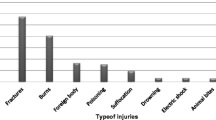Abstract
Introduction
Children in low- and middle-income countries (LMIC) often receive care outside the formal medical sector. Improving pre-hospital first aid has proven to be highly cost-effective in lowering trauma mortality. Few studies in LMIC have examined home first aid practices for injured children.
Methods
We conducted a representative population-based survey of 200 caregivers of children under 18 years of age, representing 6520 households. Caregivers were interviewed about their first aid practices and care-seeking behaviors when a child sustained an injury at home. Injuries of interest included burns, lacerations, fractures and choking. Reported practices were characterized as recommended, low-risk, and potentially harmful.
Results
For common injuries, 75–96 % of caregivers reported employing a recommended practice (e.g., running cool water over a burn injury). However, for these same injuries, 13–61 % of caregivers also identified potentially harmful management strategies (e.g., applying sand to a laceration). Choking had the highest proportion (96 %) of recommended first aid practice: (e.g., hitting the child’s back) and the lowest percent (13 %) of potentially harmful practices (e.g., attempting manual removal). Fractures had the lowest percent (75 %) of recommended practices (e.g., immediately bringing the child to a health facility). Burns had the highest percent (61 %) of potentially harmful practices (e.g., applying kerosene).
Conclusions
While most caregivers were aware of helpful first aid practices to administer for a child injury, many parents also described potentially harmful practices or delays in seeking medical attention. As parents are the de facto first responders to childhood injury, there are opportunities to strengthen pre-hospital care for children in LMICs.
Similar content being viewed by others
References
Lozano R, Naghavi M, Foreman K et al (2012) Global and regional mortality from 235 causes of death for 20 age groups in 1990 and 2010: a systematic analysis for the global burden of disease study 2010. Lancet 380(9859):2095–2128
Peden M, McGee K, Krug E (2002) Injury: a leading cause of the global burden of disease, 2000. World Health Organization, Geneva
IHME. Data visualizations. Seattle (2013) http://vizhub.healthdata.org/gbd-cause-patterns/. Accessed 16 Dec 2014
Mock CN, Jurkovich GJ, nii-Amon-Kotei D et al (1998) Trauma mortality patterns in three nations at different economic levels: implications for global trauma system development. J Trauma 44(5):804–812
Sasser S, Varghese M, Kellermann A et al (2005) Prehospital trauma care systems. World Health Organ, Geneva
Husum H, Gilbert M, Wisborg T et al (2003) Rural prehospital trauma systems improve trauma outcome in low-income countries: a prospective study from North Iraq and Cambodia. J Trauma 54(6):1188–1196
Jayaraman S, Mabweijano JR, Lipnick MS et al (2009) Current patterns of prehospital trauma care in Kampala, Uganda and the feasibility of a lay-first-responder training program. World J Surg 33(12):2512–2521. doi:10.1007/s00268-009-0180-6
Tiska MA, Adu-Ampofo M, Boakye G et al (2004) A model of prehospital trauma training for lay persons devised in Africa. Emerg Med J 21(2):237–239
Johns Hopkins School of Public Health (2013) Family health and wealth study, Insights on wealth measurement and change. http://www.jhsph.edu/departments/population-family-and-reproductive-health/_docs/seminar-2013-02-20-fhws-presentation.pdf. Accessed 17 May 2014
Gyedu A, Nakua EK, Otupiri E et al (2014) Incidence, characteristics and risk factors for household and neighbourhood injury among young children in semiurban Ghana: a population-based household survey. Inj Prev
Linnan M, Giersing M, Cox R et al (2007) Child mortality and injury in Asia: an overview. Florence: UNICEF Innocenti Research Centre. Contract No.: 2007-04
Wansi E, Mtango D, Maganga E et al (2000) Community IMCI baseline survey in Malawi. UNICEF. http://www.medcol.mw/commhealth/publications/UNICEF%20Malawi%20HCPS.pdf. Accessed 28 Oct 2014
Falkenberg T, Sawyer J, Zhang X et al (2002) WHO traditional medicine strategy 2002–2005. WHO, Geneva
O’Brien KS, Soliman AS, Annan K et al (2012) Traditional herbalists and cancer management in Kumasi, Ghana. J Cancer Education 27(3):573–579
Ellis AA, Winch P, Daou Z et al (2007) Home management of childhood diarrhoea in southern Mali—implications for the introduction of zinc treatment. Soc Sci Med 64(3):701–712
Othero DM, Orago AS, Groenewegen T et al (2008) Home management of diarrhea among underfives in a rural community in Kenya: household perceptions and practices. East Afr J Public Health 5(3):142–146
Ukwaja KN, Talabi AA, Aina OB (2012) Pre-hospital care seeking behaviour for childhood acute respiratory infections in south-western Nigeria. Int Health 4(4):289–294
Mock CN, Tiska M, Adu-Ampofo M et al (2002) Improvements in prehospital trauma care in an African country with no formal emergency medical services. J Trauma 53(1):90–97
Spangenberg K, Mock C (2006) Utilization of health services by the injured residents in Kumasi, Ghana. Int J Inj Contr Saf Promot 13(3):194–196
Mock C, Ofosu A, Gish O (2001) Utilization of district health services by injured persons in a rural area of Ghana. Int J Health Plann Manage 16(1):19–32
Aries MJH, Joosten H, Wegdam HHJ et al (2007) Fracture treatment by bonesetters in central Ghana: patients explain their choices and experiences. Trop Med Int Health 12(4):564–574
Rahman A, Miah AH, Mashreky SR et al (2010) Initial community response to a childhood drowning prevention programme in a rural setting in Bangladesh. Inj Prev 16(1):21–25
Rahman F, Bose S, Linnan M et al (2012) Cost-effectiveness of an injury and drowning prevention program in Bangladesh. Pediatrics 130(6):e1621–e1628
Acknowledgments
We wish to express our sincere thanks to all caregivers who participated in the study.
Conflict of interest
The authors have no conflicts of interest or financial ties to disclose.
Funding
This study was funded, in part, by a Grant (D43-TW007267) from the Fogarty International Center, US National Institutes of Health. The content is solely the responsibility of the authors and does not necessarily represent the official views of the National Institutes of Health.
Author information
Authors and Affiliations
Corresponding author
Rights and permissions
About this article
Cite this article
Gyedu, A., Mock, C., Nakua, E. et al. Pediatric First Aid Practices in Ghana: A Population-Based Survey. World J Surg 39, 1859–1866 (2015). https://doi.org/10.1007/s00268-015-3061-1
Published:
Issue Date:
DOI: https://doi.org/10.1007/s00268-015-3061-1




